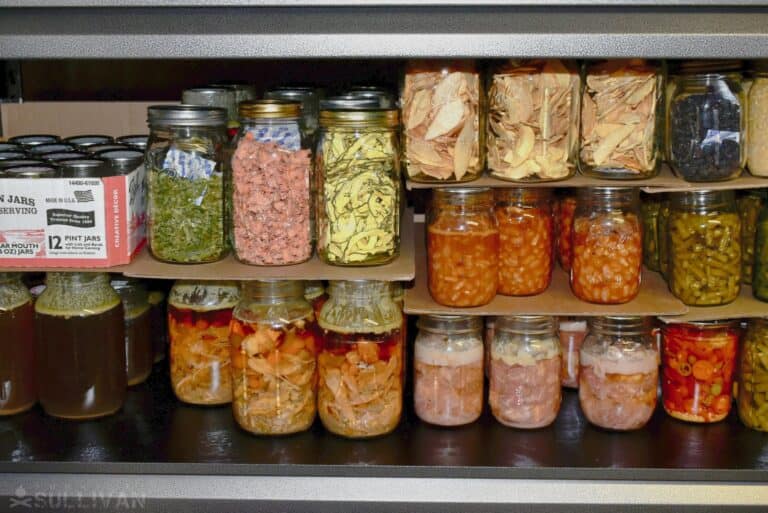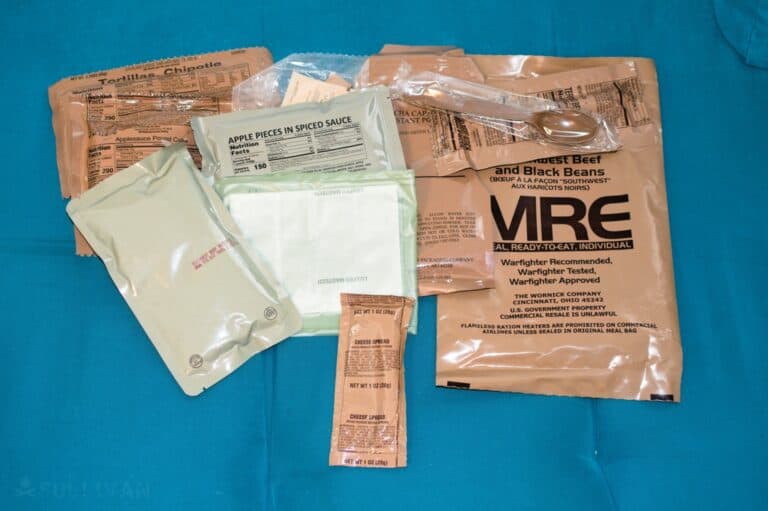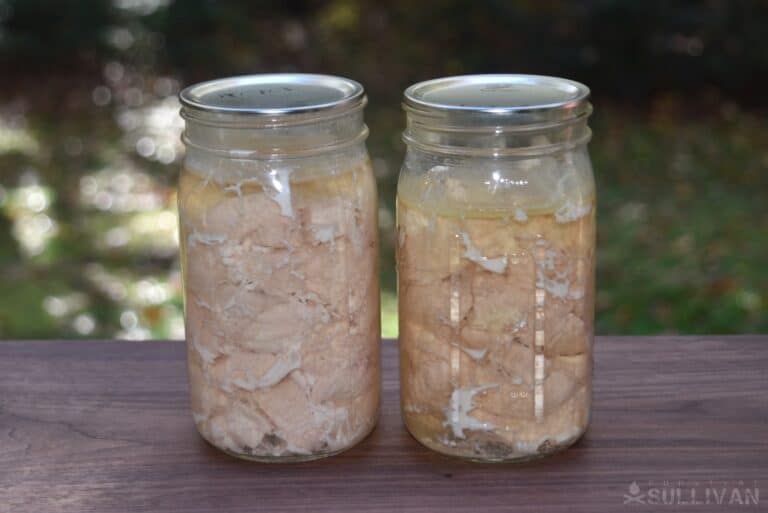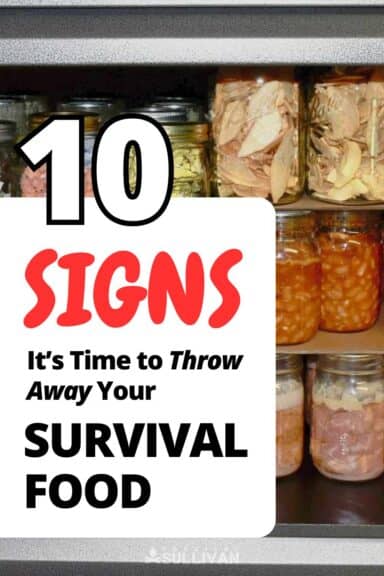One of the smartest things any prepper will do is assemble a stash of survival food. Whether you’ve got a 3-day supply, 30-day supply, 3-month supply, or even a year’s worth, once you’ve got all the boxes checked and the food packed away, your job isn’t done.

Home (pressure) canned and dehydrated long term pantry meals and sides.
You’ve got to stay on top of inspecting and rotating your food; otherwise, it can go bad, and you’ll find it inedible when you need it most. If you’re really unlucky, you’ll wind up eating food that’s become dangerously toxic.
We don’t want that to happen, and for that reason, it’s important you learn these 10 signs that it’s time to throw your stashed survival food away and get fresh stuff. Let’s get right into it.
Popped Lid
For any food you have stashed in a glass jar with a screw-on lid, be it home-canned or factory-packed, check the button on the lid periodically: it should be flat and firm, unmoving.
If it’s popped up or if it flexes or dings when you press it with a finger, that’s an indicator that the seal has been compromised and that air has gotten into the contents.
Nine times out of 10, the food will already be bad. If it’s anything you’ve had in storage for months on end, you should assume as much and throw it out. It’s just not worth the risk!
Swelling
For any food that is packed in a foil pouch or, more commonly, a tin can, be on the lookout for signs of swelling. Typically, either end will take on a domed appearance, or you might notice bulging around the waistline of the can itself.
It’s often easy to tell by trying to stand the can on its side or on both ends. If it rocks back and forth, you’ve definitely got a problem.
This swelling is caused by the formation of bacteria, which subsequently generate gas as they break down the food inside. This gas pressure can be substantial, and it causes the aforementioned swelling. Swelling is always an immediate indicator that you should discard the food; don’t even open it!
Hissing / Spurting
Another gas pressure-related problem caused by the proliferation of bacteria (as discussed just above): if you ever crack the seal on a can, pouch, or any other container and it lets out a substantial hiss or, worse, actually spurts liquid out on you, that is an immediate sign that the food is no good.
But this requires a little bit of discernment: home-canned and factory-packaged food typically creates a vacuum that will produce a short, crisp hiss or pop that isn’t a problem. But if you notice that it’s especially loud, forceful, or that there’s any liquid coming out, you can’t risk it.
Leaking
This is an easy one. Any packaging that is leaking liquid or anything else has been compromised one way or another and must be discarded. Also, keep an eye out for subtler oily stains on labels and around rims.
If it isn’t immediately apparent that the stain has come from something external, you cannot take any chances with it.

open beef and black beans MRE
Obvious Mold
I’ll bet most people are already tracking on this issue: if you open up any kind of food in any kind of container and you see mold on it, the food is spoiled. Don’t get any ideas about trying to scrape the mold off and eat the “good” parts. It’s all bad, trust me!
Likewise, don’t get caught up in any silliness regarding the color of the mold. Black, gray, green, purple, white, or any other kind is all bad news. Trash it.
Slimy Buildup
For canned meats, soups with meat, and anything that has a gravy or thick sauce, look for a vaguely iridescent layer of slime forming on top of it. It’s kind of hard to describe, but it’s one of those things where you’ll know it when you see it.
It kind of looks like an oil slick, and it definitely doesn’t look right. This is yet another good reason why you should rotate your food regularly: pull out and eat older items before they go bad so you’ll be very familiar with what normal looks like.
Rank Odor
The most immediately noticeable and certainly the most offensive indicator of spoilage for any kind of food. If it smells noxious, nasty, unusually tangy, or rank, it’s bad. No ifs, ands, or buts. Toss it out and don’t look back.
Also, a cautionary tale: certain kinds of bacterial contamination, namely the dreaded Clostridium botulinum responsible for causing botulism, can turn your food toxic without giving any obvious indicators of a bad odor or appearance, so you can’t rely on odor alone for safety!

two jars of canned chicken breasts
Rusting
For metal cans, any that have serious deposits of rust at any point—and especially around the lid or bottom—are very likely to be compromised and spoiled. That’s because rust can basically drill into the surface enough to physically breach it, allowing air in and fomenting spoilage.
A little trace of rust, especially light dust rust that’s easily wiped away, isn’t a cause for concern, but heavy, scaly patches of rust make a can too dodgy to trust.
Big Dents
Cans will get dented from drops, impact, and rough handling. A little dent in the side usually isn’t a big deal, but a dent around the rim could cause the seal to fail. Similarly, any can that has a big dent, let’s call it a half inch or more deep, should be discarded.
Dents often happen during moving, rotation, and other inspections, but you can also find dented merchandise for sale in the closeout bin at grocery stores. Don’t be tempted by these damaged goods.
Signs of Pest Attack or Infestation
Last and certainly not least, if there is any indicator of direct attack by pests, or worse, ongoing infestation, throw the food away. No questions and no caveats.
For bulk goods like grain, rice, beans, and so forth, you might find evidence of insects, insect eggs, or their droppings.
Soft containers, including plastic food storage buckets, and even foil pouches can be nibbled open by rodents that can smell the food inside. You shouldn’t need me to tell you that you can’t risk eating any of this stuff after this.

The post 10 Signs It’s Time to Throw Your Survival Food Away appeared first on Survival Sullivan.
By: Tom Marlowe
Title: 10 Signs It’s Time to Throw Your Survival Food Away
Sourced From: www.survivalsullivan.com/throwing-away-survival-food/
Published Date: Sat, 15 Feb 2025 13:51:18 +0000
------------------------
 What is BushcraftSurvival SkillsToolsVideosBushcraft CampsBushcraft KitsBushcraft ProjectsPrivacy PolicyTerms And Conditions
What is BushcraftSurvival SkillsToolsVideosBushcraft CampsBushcraft KitsBushcraft ProjectsPrivacy PolicyTerms And Conditions
